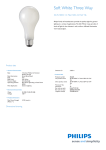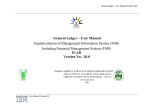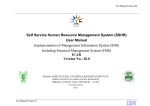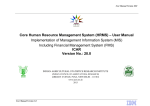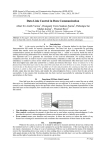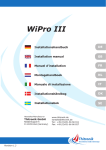Download Load Tests Through Jmeter & Case Study
Transcript
Load Tests Through
Jmeter & Case Study
Presented By
Rupesh Garg &Vamsi Krishna
Pothugunta,
Wipro Technologies.
1
© 2012 WIPRO LTD | WWW.WIPRO.COM | INTERNAL
Agenda
2
1
Introduction
2
Define Load Testing
3
Preparation of test plan for web application
4
Recording user actions with Jmeter
5
Customizing the test plan
6
Summary
7
Case Study
© 2012 WIPRO LTD | WWW.WIPRO.COM | INTERNAL
Introduction
• The success of open-source software has been remarkable,
forcing even the largest commercial software vendors to
acknowledge its influence.
• Another major factor is the current economic
environment.
• Open source looks attractive from a cost perspective,
although IT departments are finding out that open source
does not always mean the overall cost of a project will go
down.
• While software licensing costs are reduced by taking up
open-source software which will let the total project
budget go down, same time the expectations around
delivery time, quality, and support do not change.
3
© 2012 WIPRO LTD | WWW.WIPRO.COM | INTERNAL
Introduction
• Current market conditions have caused software
companies to cut back on spending. This has indirectly
undermined one of the main arguments used by the
commercial software development firms against open
source: quality of support.
• In this document we would like to discuss about the tool
“Jmeter” which is from that open source software family.
Apache Jmeter is open source performance testing tool, a
100% pure Java desktop application designed to load test
functional behavior and measure performance.
• It was originally designed for testing Web Applications
but later it has expanded to test other functions as well.
Jmeter is having almost all the basic features that a
commercial tool is having.
4
© 2012 WIPRO LTD | WWW.WIPRO.COM | INTERNAL
• Now in the current version (2.8) of Jmeter, it supports
testing the following applications
• Advanced Web Test Plan
• JDBC
• FTP
• JMS Point-to-Point
• JMS Topic
• LDAP
• LDAP Extended
• Web Services (SOAP).
• TCP
5
© 2012 WIPRO LTD | WWW.WIPRO.COM | INTERNAL
Definition of Load Testing
Load Tests are end to end performance
tests under anticipated production load.
The objective of this test is to determine
the response times for various time
critical transactions and business
processes and ensure that they are
within Service Level Agreements (SLAs).
Load tests also measures the capability
of an application to function correctly
under load, by measuring transaction
pass/fail/error rates.
There are various kind of Load tests,
varies depending on the pattern in
which they are executed against the
application.
6
© 2012 WIPRO LTD | WWW.WIPRO.COM | INTERNAL
Definition of Load Testing cntd.,
Here comes various phases in
performance testing.
• Requirements phase:
• In this phase initial details were
gathered regarding application &
scope of testing activities.
• Test Goals & Objectives
• Test Entry & Exit criteria
• Defining or taking already existing
SLA’s
• Analyzing software & Hardware
requirements
7
© 2012 WIPRO LTD | WWW.WIPRO.COM | INTERNAL
• Definition of Load Testing cntd.,
Planning Phase:
• Preparing Test plan & Strategies.
• Choosing Testing & monitoring tools.
• Finalizing the critical scenarios, work load design, Test
scripts & design of scenarios.
• Test readiness review.
Environment Setup
• Setting up test bed as per the requirements.
• Involves installation of tools, access to environment etc.,
8
© 2012 WIPRO LTD | WWW.WIPRO.COM | INTERNAL
• Definition of Load Testing cntd.,
Execution Phase
• Setting up the test data required for execution.
• Performance test scenario execution.
• Analyzing the test results.
• Identification of bottlenecks.
• Generate performance analysis report with all the performance
attributes of the application.
• This is iterative phase, depends on how the application is responding.
• If the SLAs are met then proceed to next phase.
• Else repeat the same tests after the fix provided based on the analysis.
• Completion phase
• This phase involves creation, submission & acceptance of the final
performance test report.
9
© 2012 WIPRO LTD | WWW.WIPRO.COM | INTERNAL
• Definition of Load Testing cntd.,
• Below image shows the pictorial representation of phases in order.
10
© 2012 WIPRO LTD | WWW.WIPRO.COM | INTERNAL
3. Preparation of test plan for a web application:
• In this document we are providing the
detailed information about performance
testing of a typical web application. Process
will be the same as explained in the previous
section.
• Various elements are available in Jmeter tool
through which you can design your test plan
based on the requirement. It holds all the
elements of the test designed.
• These elements are listed in this document
keeping HTTP/HTML protocol in mind.
11
© 2012 WIPRO LTD | WWW.WIPRO.COM | INTERNAL
3. Preparation of test plan for a web application cntd.,
• Test Plan:
12
© 2012 WIPRO LTD | WWW.WIPRO.COM | INTERNAL
3. Preparation of test plan for a web application cntd.,
• 3.1 Thread Group:
• This is the basic
component which
accommodates all the test
elements in the test plan.
• In thread group provides
option to mention the
number of users or threads
we want to emulate and
the rate at which they
need to hit the server
which we are testing and
the number of iterations
the users were supposed to
run.
13
© 2012 WIPRO LTD | WWW.WIPRO.COM | INTERNAL
3. Preparation of test plan for a web application cntd.,
• Even we can schedule the test. Please check the scheduler box
so that it will list the options when to start and stop the test or
you can directly give relative start and stop time.
14
© 2012 WIPRO LTD | WWW.WIPRO.COM | INTERNAL
3. Preparation of test plan for a web application cntd.,
• 3.2 HTTP Request
Defaults:
This element lets you set default
values that your HTTP Request
controllers use. For example, if
you are creating a Test Plan
with 25 HTTP Request
controllers and all of the
requests are being sent to the
same server, you could add a
single HTTP Request Defaults
element with the "Server
Name or IP" field filled in.
Then, when you add the 25
HTTP Request controllers,
leave the "Server Name or IP"
field empty. The controllers
will inherit this field value
from the HTTP Request
Defaults element.
15
© 2012 WIPRO LTD | WWW.WIPRO.COM | INTERNAL
3. Preparation of test plan for a web application cntd.,
• 3.3 Listeners to View &
Store the Test Results:
• Listener is the component which
is used to see the response times
and the content, please do add
the specific listener based on
your requirement adding
needless components to the test
plan is not recommended.
• Listener used to debug the test
script you recorded is view
results tree. Where in which, you
can see the request and
response. Even it is handy while
doing any correlation.
16
© 2012 WIPRO LTD | WWW.WIPRO.COM | INTERNAL
4. Recording user actions with Jmeter:
• First to follow is add a thread group to test plan, add a
non test element HTTP Proxy server to work bench.
• The purpose of HTTP Proxy server is to capture the
request sent to server you are accessing. Give the port
number as 8080 and select the target controller in
which you want to collect the requests.
• Now move the HTTP Proxy server to your test plan.
• Next step is to add HTTP request default to your test
plan.
• In HTTP request defaults, for “server name or Ip” give
the Ip address or domain name and give the port
number in the port field.
• Give the path in the field path. Please observe in the
below given snapshot.
17
© 2012 WIPRO LTD | WWW.WIPRO.COM | INTERNAL
Recording user actions with Jmeter cntd.,
18
© 2012 WIPRO LTD | WWW.WIPRO.COM | INTERNAL
Recording user actions with Jmeter cntd.,
• Things rounded in blue line
are test plan, server or IP,
port number in HTTP
request defaults component.
• Now open internet explorer
window. Go to internet
options tools LAN
settings give server as local
host or the machine on
which you are doing
recording, port as 8080 and
click ok.
• Go to HTTP Proxy server and
click on START button. Now,
open internet explorer and
give the URL in the browser
and click go. You can
observe the request would
be captured under selected
target controller.
19
© 2012 WIPRO LTD | WWW.WIPRO.COM | INTERNAL
Recording user actions with Jmeter cntd.,
• Things rounded in blue line are the captured
requests under selected target controller.
• Now add a listener based on your
requirement to see the response times and
response content. Listener is the component
which is used to see the response times and
the content, add the specific listener based
on your requirement.
20
© 2012 WIPRO LTD | WWW.WIPRO.COM | INTERNAL
5. Customizing the test plan:
5.1 Parameterization or Data driven Testing:
• When testing any applications, you may want to
check how the application performs the same
operations with multiple sets of data. For example,
suppose you want to check how a Web site responds
to ten separate sets of data. You could record ten
separate tests, each with its own
set of data. Alternatively, you can create Data Table
parameters so that your test runs ten times, each
time using a different set of data. This way of setting
parameters is called parameterization.
21
© 2012 WIPRO LTD | WWW.WIPRO.COM | INTERNAL
Customizing the test plan cntd.,
• Every load test should at least require parameterization.
Parameterization includes passing different types of data into
the application to emulate the real world users
performing/entering different values.
• The above can be implemented in Jmeter with the help of CSV
Data set configuration element.
• First we have to identify the value that needs to be
parameterized.
• Then replace the value with a variable in the respective HTTP
Request.
• As shown in the below snapshot. Select the http request in
which the value need to be parameterized. Syntax to be
followed for naming the variable is
• Ex: ${variablename}.
22
© 2012 WIPRO LTD | WWW.WIPRO.COM | INTERNAL
Customizing the test plan cntd.,
23
© 2012 WIPRO LTD | WWW.WIPRO.COM | INTERNAL
Customizing the test plan cntd.,
• After replacing the value
with variable add CSV data
set config element to the test
plan.
• Go to CSV data set config
element.
• Before File name please
provide the location of the
data file where it is placed.
• Provide the variable names
which are parameterized
before variable names.
• Delimiter used in the file
should be mentioned before
delimiter field.
24
© 2012 WIPRO LTD | WWW.WIPRO.COM | INTERNAL
Customizing the test plan cntd.,
5.2 .Verification Points or
assertions:
• Some times while doing
performance testing you
need to validate how the
application is giving the
responses under load. To
validate the responses
there are some elements
provided in Jmeter those
are called as Assertion
elements. Different types
of assertion elements are
available based on the
type of response you are
25 validating.
© 2012 WIPRO LTD | WWW.WIPRO.COM | INTERNAL
Customizing the test plan cntd.,
5.3. Correlation:
Correlation is the capturing of dynamic values passed from the server to
the client and back. You save this captured value into a parameter, and
then use this parameter in the script in place of the original value and
when it makes requests of the server, send this new, valid value back to
the server.
Correlation is where the script is modified so that some of the hard coded
values in the script are no longer hard coded. Rather then sending the
original value to the server, we may need to send different values.
Correlated data is data which is sent to the Client from the Server, and
later sent back to the Server by the Client.
For example, the original recorded script may have included the server
sending the client a session identification number, something to identify
the client during that particular session. This Session ID was hard coded
into the script during recording.
26
© 2012 WIPRO LTD | WWW.WIPRO.COM | INTERNAL
Customizing the test plan cntd.,
During replay, the server will
send the client a new Session ID.
You need to capture this value,
and incorporate it into the script
so you can send it back to the
server to correctly identify
yourself for this new session. If
you leave the script unmodified,
you will send the old hard coded
Session ID to the server. The
server will through an exception
as the session id is invalid, or
unknown, and so will not send
the pages that have been
requested.
27
© 2012 WIPRO LTD | WWW.WIPRO.COM | INTERNAL
Customizing the test plan cntd.,
Explore the request for which server is sending dynamic responses.
For that request add regular expression extractor available in post
processors. Mention the variable name into which you want store
the extracted value. Give the regular expression based on the type of
value that needs to be extracted in between left and right
boundaries before regular expression field. Field Match no
represents the instance which you want to match. If the desired
value is not extracted then the default value will be substituted in
the variable in the above Snap shot ERROR is given as the default
value.
The variable name has to be placed in the subsequent request in
place of dynamic value, so that server will recognize the current
session that extracted in to the variable. Below figure the dynamic
value is replaced with the variable name into which we have taken
the dynamic response from the server.
28
© 2012 WIPRO LTD | WWW.WIPRO.COM | INTERNAL
Customizing the test plan cntd.,
This concludes the
general preparation
of a web test plan
and customization.
There are still more
elements available,
use the elements
based on your
requirements. The
more work Jmeter
doing makes it lesser
accurate so prepare
the test plan
accordingly.
29
© 2012 WIPRO LTD | WWW.WIPRO.COM | INTERNAL
6. Summary:
Overall as an Open source tool, it provides almost all
the features that a commercial tool is having currently
in the market. This tool will be very handy for small
and medium budget projects where budget allocated
for the tool licensing is less. Also it is easy to learn and
use.
30
© 2012 WIPRO LTD | WWW.WIPRO.COM | INTERNAL
6. Summary:
Pros:
No Tool licensing costs.
Easy to use, especially for the protocols like Web services, FTP,
JDBC.
Testers can easily learn & implement.
Using this tool we can do record & replay the tests.
Correlation & Data driven testing is possible through this tool.
Cons:
As it is an open source tool, support for the tool is not available.
Have to rely on the Apache User manual & Support forums.
Compared to commercial tools available in the market, usability
of the tool is difficult if you are working on complex web
applications were correlations are more.
Customized results will not be available from this tool.
31
© 2012 WIPRO LTD | WWW.WIPRO.COM | INTERNAL
7. Case study:
This is the tool we used in performance testing of the key modules
in Aircel Transformation testing assignment through which we
reduced the licensing cost involved in procuring test tools.
The procedure which we followed involves lot of manual
intervention as the application we tested is an integrated
application. The application for which we measured the
performance is given below.
Tool Jmeter emulates retailer and distributor. From the tool
we are sending the request for registration and activation.
Process of registration starts by sending 111 requests
(Registration) which retailer use to do for requesting to activate
services to a new sim. Logging is enabled at various levels to
calculate the response times. Same for activation also but here
the sender will become distributor. Based on the input
parameters it will do the intended action.
32
© 2012 WIPRO LTD | WWW.WIPRO.COM | INTERNAL
Case study:
Here instead of retailer, requests were sent by Jmeter to the
server, excluded network elements. Requests were sent by
parameterising the new sim number. Once the request reaches
esb the transactions we used to measure are
Time at which request reached Esb.
Time at which IVR flag was updated in CRM DB.
Time took to update registration request in activation DB.
Finally messages will be delivered to retailer, distributor
regarding the status of the request.
All the times measured above are manually through the logs from
the respective servers.
The test conducted to measure the transaction response time at
various ends.
33
© 2012 WIPRO LTD | WWW.WIPRO.COM | INTERNAL
By using Jmeter we were
able to simulate the
above core telecom
application to validate
the end to end
performance. Though
manual intervention is
required to collect the
data points at various
tiers, we have reduced
the tool licensing costs
by using this without
compromising on the
quality of the outcome.
34
© 2012 WIPRO LTD | WWW.WIPRO.COM | INTERNAL
8. References:
1. Apache Jmeter by Emily H. Halili
2. http://jakarta.apache.org
35
© 2012 WIPRO LTD | WWW.WIPRO.COM | INTERNAL
Thank You
36
© 2012 WIPRO LTD | WWW.WIPRO.COM | INTERNAL




































